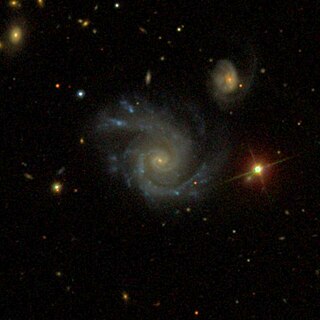
NGC 5829 is a spiral galaxy located in the constellation Boötes. It is 281 million light-years away from Earth and was discovered by astronomer, Edouard Stephan in May 1882.

NGC 6285 is an interacting spiral galaxy located in the constellation Draco. It is classified as S0-a in the galaxy morphological classification scheme and was discovered by the American astronomer Lewis A. Swift in 1886. NGC 6285 is located at about 262 million light years away from Earth. NGC 6285 and NGC 6286 form a pair of interacting galaxies, with tidal distortions, categorized as Arp 293 in the Arp Atlas of Peculiar Galaxies

NGC 6286 is an interacting spiral galaxy located in the constellation Draco. It is designated as Sb/P in the galaxy morphological classification scheme and was discovered by the American astronomer Lewis A. Swift on 13 August 1885. NGC 6286 is located at about 252 million light years away from Earth. NGC 6286 and NGC 6285 form a pair of interacting galaxies, with tidal distortions, categorized as Arp 293 in the Arp Atlas of Peculiar Galaxies.

NGC 507, also known as Arp 229, CGCG 502-67, MCG 5-4-44, PGC 5098, UGC 938, and V V 207, is a lenticular galaxy in the constellation Pisces. It was described as being "very faint", "pretty large", "round", "brighter in the middle", and "south of NGC 508" by John Dreyer in the New General Catalogue. The two galaxies are a part of the Atlas of Peculiar Galaxies, where NGC 507 is described as "Circular or near circular rings of small density difference."

NGC 6040 is a spiral galaxy located about 550 million light-years away in the constellation Hercules. NGC 6040 was discovered by astronomer Édouard Stephan on June 27, 1870. NGC 6040 is interacting with the lenticular galaxy PGC 56942. As a result of this interaction, NGC 6040's southern spiral arm has been warped in the direction toward PGC 56942. NGC 6040 and PGC 56942 are both members of the Hercules Cluster.

IC 4271 is a spiral galaxy located some 800 million light-years away in the Canes Venatici constellation. It is 130,000 light-years in diameter. IC 4271 was first located on July 10, 1896, by Stephane Javelle, a French astronomer. It hosts a Seyfert type 2 nucleus, containing an acceleration disc around its supermassive black hole which releases large amounts of radiation, hence its bright appearance. IC 4271 appears to be interacting with its smaller neighboring galaxy, PGC 3096774.

Arp 146 are a pair of interacting galaxies located 1.05 billion light-years away from Earth in the Cetus constellation. According to a study, one galaxy appears to have passed through another, leaving behind a ring formed from the bridge material and remnants of the nucleus. Under the Atlas of Peculiar Galaxies created by Halton Arp, they are categorized under galaxies that have associated rings.

UGC 934, known as PGC 5085, is a large spiral galaxy about 470 million light-years away from the solar system. It is located in the constellation of Pisces and about 285,000 thousand light-years in diameter. With its neighboring galaxy PGC 212740, they together form Arp 70, the 70th number in the Atlas of Peculiar Galaxies which was created by Halton Arp. In this class, they fall under spiral galaxies that have a small high-surface brightness companions.
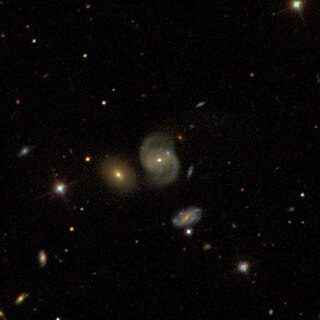
IC 4461 is a spiral galaxy located in the Boötes constellation, located at distance of 417 million light-years from both the Milky Way and Andromeda Galaxy.
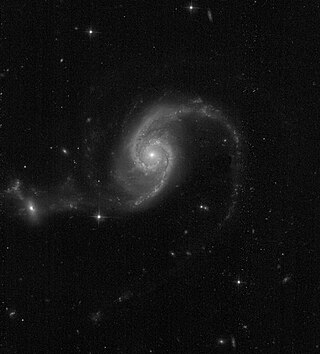
UGC 4457 known as PGC 23935, is a barred spiral galaxy, containing an active galactic nucleus in the Cancer constellation. It is located 500 million light-years away from the Solar System and has a diameter of 290,000 light-years, making it slightly more massive compared to the Milky Way. The galaxy is moving away at a speed of 11,162 kilometers per second.
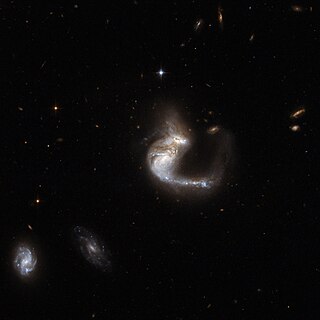
UGC 4881 is a pair of interacting galaxies, UGC 4881A and UGC 4881B. They are located in the constellation Lynx, some 500 million light-years away. UGC 4881, the brighter, is a peculiar spiral galaxy. It has been heavily documented by the Hubble Space Telescope, and is cataloged in the Atlas of Peculiar Galaxies.
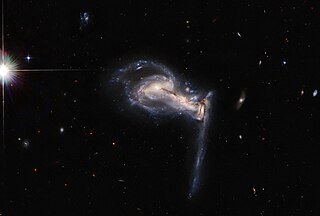
UGC 4653 known as Arp 195, is a trio of interacting galaxies located 763 million light-years away from the solar system in the Lynx constellation. The galaxies are being distorted through gravitational interactions with each other.

UGC 1840 known as Arp 145, are a pair of interacting galaxies located 250 million light-years away from the Solar System in the Andromeda constellation. Made up of two galaxies, UGC 1840 NED01 and UGC 1840 NED02, the two galaxies had recently collided with each other in which the elliptical galaxy has penetrated through the spiral galaxy's nucleus leaving a hole in its middle, thus forming a ring galaxy. With a diameter of 1.3 arc minutes, close to 100,000 thousand light-years, they are roughly the same size as the Milky Way.

NGC 3753 is a large spiral galaxy with a bar located in the Leo constellation. It is located 435 million light-years away from the Solar System and was discovered on February 9, 1874, by Ralph Copeland.

NGC 3750 is a lenticular galaxy with a bar located in the constellation of Leo. It is located 450 million light-years from the Solar System and was discovered by Ralph Copeland on February 9, 1874.

NGC 3748 is a lenticular galaxy with a bar located in the Leo constellation. It is located 440 million light-years away from the Solar System and was discovered by Ralph Copeland on April 5, 1874, but also observed by Hermann Kobold, Lawrence Parsons and John Louis Emil Dreyer.

NGC 3754 is a small barred spiral galaxy located in Leo. It is located 447 million light-years away from the Solar System and was discovered on April 5, 1874, by Ralph Copeland.
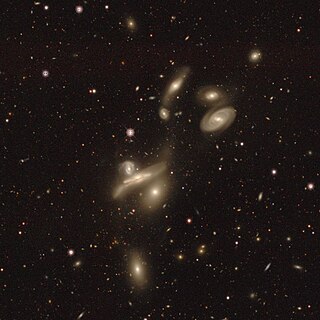
NGC 3745 is a lenticular galaxy with a bar structure located in the constellation of Leo. NGC 3745 is located 471 million light-years away from the Solar System and was discovered by Ralph Copeland on April 5, 1874, but also observed by Hermann Kobold, Lawrence Parsons and John Louis Emil Dreyer.

NGC 3751 is a type E-S0 lenticular galaxy located in the Leo constellation. It is located 450 million light-years away from the Solar System and was discovered by Ralph Copeland on April 5, 1874.
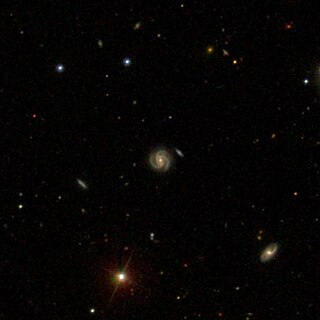
Arp 60 also known as LEDA 1762846, is a barred spiral galaxy located in Coma Berenices. It is located 958 million light-years from the Solar System and has an approximate diameter of 95,000 light-years.















